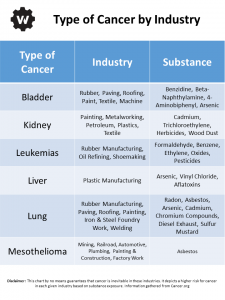Workplace dangers and asbestos
When you’re on a job site, you focus on deadlines, production, and avoiding injury.
Remembering to wear a hard hat to protect your head might be easy enough, but do you consider other less visible dangers? If that hard hat is loose, you tighten it securely.
Do you do the same with a respirator? Do you even wear one?
According to OSHA, anywhere from 381,000 to 762,000 cancer diagnoses stem from prolonged exposure to workplace carcinogens.
Related: The OSHA Asbestos Standard
West Virginia native Virgil Anderson became part of that demographic just over one year ago when the 50-year-old was diagnosed with mesothelioma caused by workplace asbestos exposure.
“I worked in building demolition and excavating since high school,” Anderson said.
“This required the physical tear out and hands-on removal of walls, ceilings, attics, heating systems and cooling systems. I also worked as an auto mechanic. I’ve repaired or replaced just about everything you can think of in many types of vehicles.”
Living with mesothelioma
Anderson’s diagnosis came after he woke up one morning with a stubborn-turned-debilitating cough.
He struggled with breathing so much that relatively easy tasks, such as walking to the mailbox, became increasingly difficult. Even while resting, Anderson had trouble catching his breath.
Initially, emergency room doctors believed he had pneumonia and prescribed antibiotics. After weeks without resolve, a return trip to the hospital for additional testing, which included a biopsy, confirmed that he developed the rare and aggressive cancer.
“I had never thought that one day I’d hear the words ‘you have cancer,’ especially mesothelioma…[which is] caused by asbestos,” Anderson said.
“How can someone so young and physically active their whole life have cancer? I was angry, sad, confused. I took it upon myself to figure out how and where my exposure came from. I found a few websites on the internet that [were] focused on mesothelioma. I couldn’t believe how many products contained asbestos: concrete, insulation, bricks, floor tiles, ceiling tiles, and many automotive parts. This explained everything.”
Over the past year, Anderson’s health and quality of life have deteriorated considerably.
He’s no longer able to work, and he spends most of his time lugging a portable oxygen tank around.
“It isn’t easy adjusting to this new lifestyle when you’ve been so active your entire life,” Anderson added.
“I’ve become extremely limited in my activities. I am unable to do the things I used to do. But at least I’m alive. Some things are beyond our control, and feeling outraged about life’s injustices is completely normal. But, it won’t change anything in the long run. I have to stay positive and enjoy what I have left to live for.”
Sadly, Virgil Ray Anderson passed away on July 14, 2018 from complications caused by mesothelioma. He was 52-years-old.
 Don’t put off until tomorrow what you can do today
Don’t put off until tomorrow what you can do today
It may take anywhere from 10 to 50 years for the symptoms of mesothelioma to arise, and there is no known cure.
Workers may feel just fine now but, in a few years, that can quickly change, as it did for Anderson.
Asbestos isn’t the only cancer-causing substance on worksites. Radon, cadmium, silica, arsenic, and many others are also considered as highly carcinogenic.
Don’t wait for symptoms to arise, and for others to get sick. Make sure your workplace is compliant, your respirator fits, and that you’re receiving the proper medical surveillance testing. Keeping employees and worksites safe should never be optional.
For more information on mesothelioma, please visit Mesothelioma.net.





